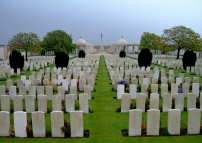| First Name: | George | Last Name: | ARNOLD | |
|---|---|---|---|---|
| Date of Death: | 26/09/1915 | Lived/Born In: | Kew | |
| Rank: | Private | Unit: | Royal West Kent8 | |
| Memorial Site: | 1. Richmond-on-Thames Memorial 2. Loos Memorial, France | |||
Current Information:Age-23 23, Haverfield Gardens, Kew
The Battle of Loos 25th September - 13th October 1915 This was fought by the British Army along a six-and-a-half-mile front running north from the mining village of Loos on the outskirts of Lens in Northern France. It was the largest offensive carried out by the British so far. The opening day involved an attack by six divisions, with others entering the fray as it progressed and it was part of a much wider offensive with the French launching their own attacks in Champagne and at Vimy. It was the first time that the British used gas during the war, despite their condemnation of the Germans for doing the same in April 1915. There were some encouraging results on the first day but no major breakthrough was achieved and in the succeeding days of it became bogged down in brutal trench warfare. By mid-October the battle had petered out with the British having suffered over 60,000 casualties during its course. The reserve Corps for the battle, XI Corps, consisted of the Guards Division and two New Army divisions, 21st and 24th Divisions, made up of volunteers who had responded to Kitchener’s appeal, and who had only arrived in France at the beginning of September 1915. Nevertheless they were soon in battle. Field Marshal French kept them back from the front when the main attack went in on 25th September but when things did not go to plan these reserves were urgently called for. Even so they were held back until the last minute which meant that they had to march across country through a night of heavy rain to reach the battlefield. It was not until the late morning of 26th September that they were in position to assault the German second line between Bois Hugo & Hulluch. But by this time the enemy had brought up reserves and were launching counter attacks which further disrupted proceedings. What happened next was a disaster. Advancing in broad daylight in ten columns, without the help of an artillery barrage these totally inexperienced divisions were cut to pieces by machine gun and rifle fire. They lost half of their number in a matter of minutes. Even the Germans were shocked at the slaughter and stopped firing to allow the survivors to withdraw. On the evening of 25th September, 24th Division crossed the railway near Vermelles and 72 Brigade (8th Royal West Surrey (Queens), 8th East Kent (Buffs), 9th East Surrey and 8th Royal West Kent) formed up around Le Rutoire Farm. It was dark when 72 Brigade moved off across the large expanse of grassland between them and the Lens road, three miles off. Progress was slow and wearisome especially crossing the original front lines where there were only narrow gaps in the German wire and but a few planks across the trenches. The Loos-Haisnes road, immediately behind the old front line was not reached until after midnight. Here they left their packs and continued forward until a message from Divisional HQ ordered a halt for the night, in trenches west of the Lens-La Bassee road.
At 11am, 26th September, 24th Division’s attack was carried out by 72 Brigade, with two battalions of 71 Brigade, 11 Essex and 9 Suffolk in reserve. The attack involved a long advance over a bare and open stretch enfiladed from both flanks and although their objective was only a single trench it was protected by wire 4 feet high and 20 feet wide. It was further protected at its ends and middle by three strong closed works, Stützpunkte III, IV & V. and a number of concrete machine gun emplacements making it a very strong position. Furthermore it had been reinforced during the night and now had six German battalions manning its one mile length. 9th East Surrey and 8th Royal West Kent led the advance, but as they moved further forward, they met increasing fire both from in front and from the flanks which desperately thinned the ranks of all four battalions of 72 Brigade. The enemy were also using field guns from Hulluch at point blank range enfilading the whole advance with shrapnel and some gas shell. The battalion diaries all claim that the British artillery was responsible for many of their casualties as they neared the German second position. Reaching the top of the rise and with another 300 yards to go they could see the strong wire and the enemy up on the parapet, shooting. But still the advance continued this time in short rushes but they could get no further than the German wire and there they went to ground with the long grass providing the only cover. Off to their right they could see the retirement of 21st Division after their attack had come to grief and with many officers killed or wounded, someone shouted "Retire" and they did. 8th Royal West Kent had 580 casualties on this day, their first in battle, one of whom was George Arnold. |
||||
| « Back to Search Results | ||||
| If you think any of the information shown here is incorrect, Click Here to submit your amends and comments | ||||




